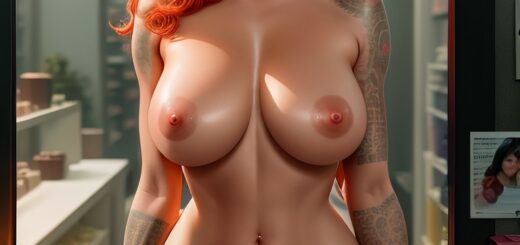Breaking Stereotypes: How 3D Comics Empower Women

Breaking stereotypes is an important part of creating a more equitable and inclusive society. 3D comics are a powerful tool for challenging gender stereotypes and empowering women. 3D comics provide a platform for female characters to take center stage and tell their stories in a way that is both entertaining and thought-provoking. Through 3D comics, women can be seen as strong, independent, and capable of achieving their goals. 3D comics also provide a platform for female creators to showcase their talents and create stories that reflect their own experiences. By breaking stereotypes, 3D comics can help to create a more equitable and inclusive society.
Exploring the Impact of 3D Comics on Breaking Gender Stereotypes
Welcome to the world of 3D comics! In recent years, 3D comics have become increasingly popular, and for good reason. Not only are they visually stunning, but they also have the potential to break down gender stereotypes and create a more inclusive comic book universe. In this blog post, we’ll explore how 3D comics are helping to challenge traditional gender roles and create a more diverse comic book landscape.
First, let’s take a look at how 3D comics are helping to break down gender stereotypes. In traditional comic books, female characters are often portrayed as weak, helpless, and overly sexualized. However, 3D comics are changing this narrative by introducing strong female characters who are capable of taking on the same roles as their male counterparts. These characters are often portrayed as independent, powerful, and capable of taking on any challenge. This shift in representation is helping to create a more balanced comic book universe and challenge traditional gender roles.
Another way 3D comics are helping to break down gender stereotypes is by introducing more diverse characters. In traditional comic books, characters are often portrayed as white, heterosexual, and cisgender. However, 3D comics are introducing characters of all genders, sexual orientations, and ethnicities. This shift in representation is helping to create a more inclusive comic book universe and challenge traditional gender roles.
Finally, 3D comics are also helping to challenge traditional gender roles by introducing more female creators. In traditional comic books, female creators are often underrepresented. However, 3D comics are helping to change this narrative by introducing more female creators into the comic book industry. This shift in representation is helping to create a more balanced comic book universe and challenge traditional gender roles.
Overall, 3D comics are helping to challenge traditional gender roles and create a more inclusive comic book universe. By introducing strong female characters, diverse characters, and more female creators, 3D comics are helping to create a more balanced comic book landscape and break down gender stereotypes. So, if you’re looking for a way to challenge traditional gender roles and create a more inclusive comic book universe, 3D comics are definitely worth checking out!
How 3D Comics are Challenging Traditional Gender Roles
3D comics are shaking up the comic book industry and challenging traditional gender roles in the process. For decades, comic books have been dominated by male superheroes and villains, with female characters often relegated to the sidelines. But 3D comics are changing that.
3D comics are a new type of comic book that uses 3D printing technology to create a unique, immersive experience. Instead of reading a flat page, readers can explore a 3D world with characters that move and interact with each other. This new technology has opened up a world of possibilities for comic book creators, allowing them to create stories that are more diverse and inclusive.
One of the most exciting aspects of 3D comics is the way they are challenging traditional gender roles. Female characters are no longer relegated to the sidelines; they are now taking center stage in 3D comics. Female superheroes are becoming more prominent, and female villains are being given more depth and complexity. 3D comics are also exploring gender identity in new and exciting ways, allowing readers to explore characters who don’t fit into traditional gender roles.
3D comics are also giving female creators a platform to tell their stories. Female comic book creators are now able to create stories that reflect their own experiences and perspectives. This is an important step forward for the comic book industry, which has long been dominated by male creators.
3D comics are revolutionizing the comic book industry and challenging traditional gender roles in the process. They are giving female characters more prominence, exploring gender identity in new ways, and giving female creators a platform to tell their stories. It’s an exciting time for comic book fans, and we can’t wait to see what the future holds!
Examining the Role of 3D Comics in Dismantling Stereotypes of Women
Welcome to the world of 3D comics! In recent years, 3D comics have become increasingly popular, and for good reason. Not only are they visually stunning, but they also provide a unique platform for exploring complex topics and dismantling stereotypes of women. In this blog post, we’ll take a closer look at how 3D comics are helping to break down gender stereotypes and empower women.
First, let’s talk about what 3D comics are. 3D comics are a type of comic book that uses 3D technology to create a more immersive experience. This technology allows readers to explore the world of the comic in a more interactive way, as if they were actually inside the story. This makes 3D comics a great tool for exploring complex topics and challenging gender stereotypes.
One of the most powerful ways 3D comics are helping to break down gender stereotypes is by creating strong female characters. In 3D comics, female characters are often portrayed as strong, independent, and capable of taking on any challenge. This is in stark contrast to the traditional portrayal of women in comics, which often depict them as weak and helpless. By creating strong female characters, 3D comics are helping to challenge the idea that women are not capable of taking on important roles.
Another way 3D comics are helping to break down gender stereotypes is by exploring topics that are traditionally seen as “male” or “female”. For example, some 3D comics feature female characters who are scientists, engineers, or even superheroes. By exploring these topics, 3D comics are helping to challenge the idea that certain topics are only for one gender.
Finally, 3D comics are also helping to break down gender stereotypes by exploring topics that are traditionally seen as “taboo”. For example, some 3D comics explore topics such as body image, mental health, and sexuality. By exploring these topics, 3D comics are helping to challenge the idea that these topics are not appropriate for women to discuss.
Overall, 3D comics are helping to break down gender stereotypes and empower women in a variety of ways. By creating strong female characters, exploring traditionally “male” or “female” topics, and exploring “taboo” topics, 3D comics are helping to create a more inclusive and empowering world for women. So, if you’re looking for a way to challenge gender stereotypes and empower women, 3D comics are definitely worth checking out!
How 3D Comics are Redefining Representations of Women in Popular Culture
The world of comics has long been dominated by male characters, with female characters often relegated to the sidelines. But with the rise of 3D comics, women are finally getting the representation they deserve.
3D comics are a new form of comic book art that uses 3D modeling software to create characters and environments. This technology allows artists to create more detailed and realistic characters, and it’s revolutionizing the way women are portrayed in comics.
For starters, 3D comics are allowing female characters to be more than just eye candy. Instead of being portrayed as objects of male desire, female characters are now being given more depth and complexity. They’re being given their own stories and motivations, and they’re being portrayed as strong, independent characters.
3D comics are also allowing female characters to be more diverse. Instead of being limited to a single body type or skin color, female characters can now be portrayed in a variety of shapes, sizes, and colors. This is helping to create a more inclusive representation of women in comics, and it’s allowing readers to see themselves reflected in the characters they’re reading about.
Finally, 3D comics are allowing female characters to be more active. Instead of being relegated to the sidelines, female characters are now taking center stage and playing an active role in the stories they’re featured in. They’re being portrayed as heroes, villains, and everything in between, and they’re being given the opportunity to show off their strength and courage.
All in all, 3D comics are helping to redefine the way women are represented in popular culture. They’re allowing female characters to be more than just objects of male desire, and they’re allowing readers to see themselves reflected in the characters they’re reading about. It’s an exciting time for female representation in comics, and it’s only going to get better from here.
Q&A
1. What is 3D Comics?
3D Comics is a form of comic book art that uses 3D computer graphics to create a more immersive and realistic experience for readers. It is a relatively new form of comic book art that has been gaining popularity in recent years.
2. How do 3D Comics empower women?
3D Comics empower women by providing them with a platform to tell their stories in a more visually engaging way. By using 3D graphics, women can create stories that are more dynamic and engaging, allowing them to break stereotypes and challenge traditional gender roles.
3. What are some of the benefits of 3D Comics?
Some of the benefits of 3D Comics include the ability to create more realistic and immersive stories, the ability to create stories that challenge traditional gender roles, and the ability to create stories that are more visually engaging.
4. How can 3D Comics be used to break stereotypes?
3D Comics can be used to break stereotypes by creating stories that challenge traditional gender roles and portray women in a more positive light. By creating stories that feature strong female characters, 3D Comics can help to break down gender stereotypes and empower women.Breaking stereotypes is an important part of creating a more equitable and inclusive society. 3D comics are a powerful tool for empowering women by providing them with a platform to tell their stories and express their perspectives. By creating characters that are strong, independent, and diverse, 3D comics can help to challenge traditional gender roles and create a more positive representation of women in the media. 3D comics can also help to foster a sense of community and solidarity among women, as well as provide a safe space for them to explore their identities and express themselves. Ultimately, 3D comics can be a powerful tool for breaking down stereotypes and creating a more equitable and inclusive society.


